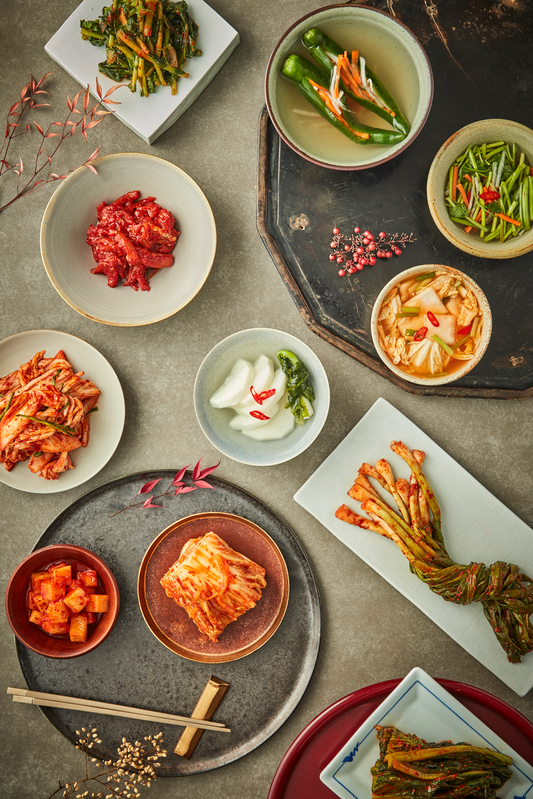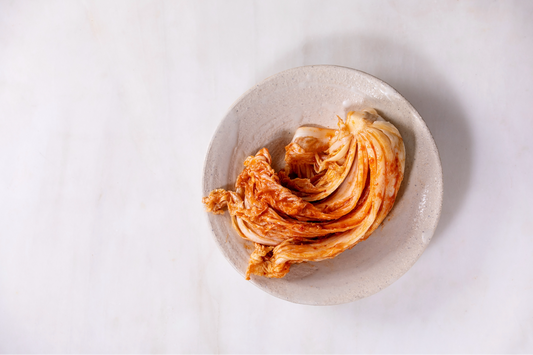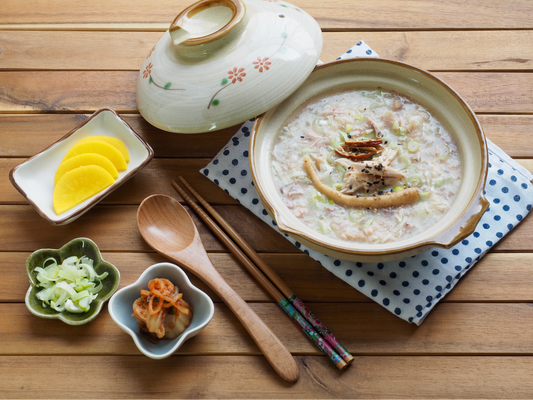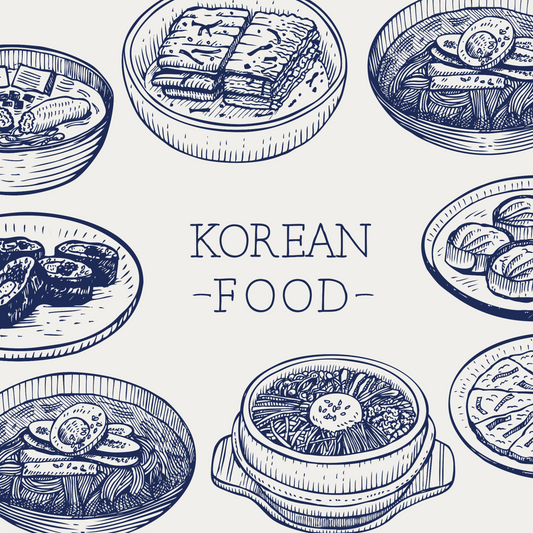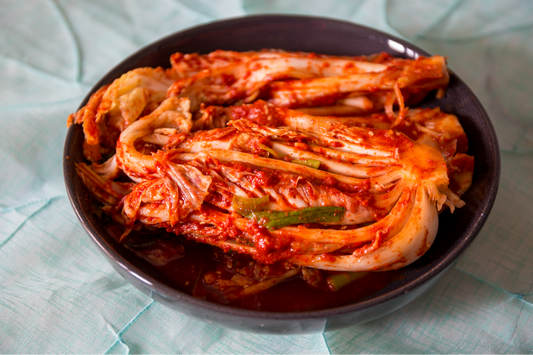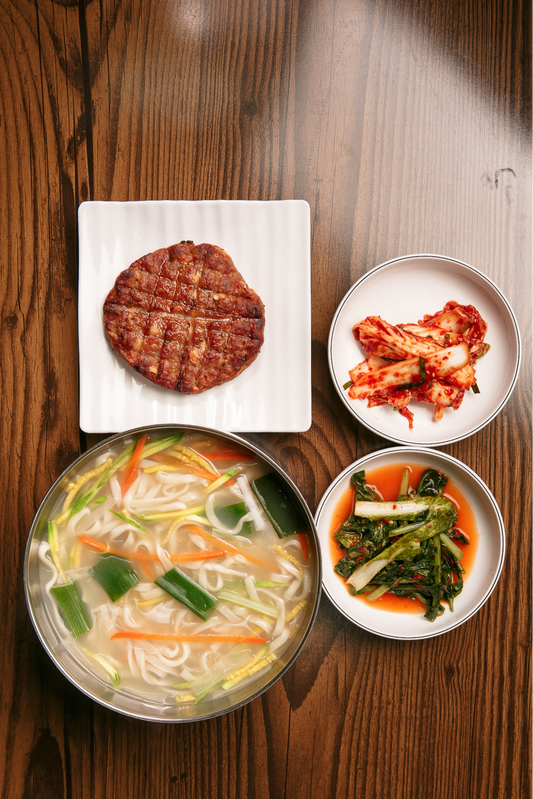Dongchimi Guksu Recipe
Korean cuisine gives us Dongchimi Guksu, a tasty cold noodle dish. It has a light broth and fresh ingredients. This guide will help you make dongchimi noodles step by step. You'll learn tips to get the flavors just right.
Ingredients and Cooking Method for Dongchimi Guksu
Start by getting crisp radishes, tangy Asian pear, and spicy chili peppers. You'll also need herbs and thin wheat noodles. First, make the dongchimi (radish water kimchi) a few days before. Mix radishes, garlic, ginger, and pear with salt and a bit of plum syrup. Then, let it ferment to develop the flavors.
Estimated Cooking Time for Dongchimi Guksu
Once the broth is ready, making Dongchimi noodles is quick. Boil the noodles for 5 to 7 minutes. Then, mix them with your prepared broth. The whole dish can be ready in under 10 minutes. It’s fast and delicious.
Difficulty Level of Dongchimi Guksu Recipe
This recipe is easy, so anyone can make it. It's great for beginners or experienced chefs. The preparation is simple, using fresh ingredients. It's a dish that's both easy to make and enjoyable to eat.
Dongchimi Guksu Cooking Tips
Starting to make dongchimi noodles is a fun way to explore Korean food. Knowing how to mix everything just right is key. This gives Dongchimi Guksu its refreshing flavor.
Secrets to Achieving the Perfect Refreshing Flavor in Dongchimi Guksu
To get dongchimi noodles right, mix the ingredients well and let the dongchimi ferment. Quality Korean radishes are important. Let them ferment for a few days for the broth to taste rich.
Adding 7-Up, as some suggest, adds a sparkly feel. This makes the noodles more refreshing with every bite.
Choosing the Best Dongchimi for Noodles
Picking the right dongchimi is very important for tasty noodles. Look for a recipe with Korean pear, ginger, and garlic. These add a crisp and tangy taste to the broth.
Boil the somen noodles until just right, then cool them quickly in cold water. This keeps them firm in the broth. For a cool twist, try making the broth slushy by partly freezing it before serving. It's really refreshing, especially on hot days.
How you make dongchimi noodles can depend on what you like. Change the sweetness or tanginess as you prefer. Always taste the broth while cooking to make sure it's seasoned just right.

Dongchimi Guksu Variations and Applications
Dongchimi Guksu is a unique dish in the kimchi and noodle dishes world. It is known for its flexibility in the kitchen. Made with thin wheat noodles and radish kimchi broth, it's a base for many tasty additions. Learning how to make dongchimi noodles lets you tailor the dish for anyone's liking and occasion.
Different Styles and Flavor Twists for Dongchimi Guksu
Looking for a different texture? Try soba or udon instead of regular noodles. They offer a chewier bite. Add cucumber slices or bell peppers for a crunch and more nutrients. And for a spicy kick, mix in finely chopped red chili or a bit of chili oil.
Adding a splash of vinegar can give the dish a tangy twist. It enhances the flavor without overwhelming Dongchimi's gentle taste. These tweaks in kimchi and noodle dishes show Dongchimi Guksu's versatility. They also reveal the fun in exploring how to make dongchimi noodles appealing to different tastes. Adding hearty ingredients or adjusting the broth's seasoning keeps Dongchimi's spirit alive. Each change offers a new eating adventure.
Health Benefits of Main Ingredients in Dongchimi Guksu
Looking at the health benefits of kimchi shows how nutritious Dongchimi Guksu can be. Dongchimi, a less spicy type of kimchi, is made with Korean radish. This radish adds valuable nutrients without the strong spice often found in other versions. So, Dongchimi Guksu is perfect for those who want the probiotics of kimchi but in a milder taste.
Health Benefits of Kimchi and Key Ingredients in Dongchimi Guksu
Dongchimi's health boost comes primarily from its key component, the Korean radish, or 'mu'. These radishes are packed with digestive enzymes like diastase, aiding in digestion. They also bring vitamins and minerals that are vital for our health. Thanks to fermentation, Dongchimi is rich in probiotics. These probiotics are great for gut health and boosting immunity.
Dongchimi also includes ingredients like apples, pears, and Korean melon. These add vitamins, antioxidants, and a sweet taste that complements the fermented radish well. Without heavy spices or seafood, Dongchimi is a good choice for vegans. It keeps all the health perks of traditional kimchi.
The dish's water-based formula makes Dongchimi Guksu perfect for staying hydrated and eating light. It's often enjoyed in the cold months, offering a warm yet refreshing taste. It's especially good for those feeling bloated or wanting a light meal among heavier options.
Recently, chefs have been mixing Dongchimi with various meals, like salads and gazpachos. This shows its flexible use and growing health appeal. By adding Dongchimi, these dishes get a nutritional lift and introduce more people to kimchi's probiotics. It's a tasty way to encourage better digestive health and overall wellness.
So, eating Dongchimi Guksu is more than enjoying its soft, unique taste. It also promotes a healthier way of living. Thanks to its rich nutritional value and the health benefits of kimchi, it's a smart choice for anyone's diet.
Taste and Aroma of Dongchimi Guksu
The dish Dongchimi Guksu mixes radish water kimchi's tartness with noodle flavors. It is both refreshing and hearty. It's famed for refreshing noodles and spicy kimchi. This cold noodle dish marries Korean culinary traditions and is perfect for hot weather.
Unique Flavor Profile and Aroma of Dongchimi Guksu
Dongchimi Guksu isn't just about taste; it's an experience. The pickled radish adds a crisp, tangy flavor that complements chewy somen noodles. It showcases Korean pickling art, highlighting natural flavors and complexity.
The aroma of the dish is inviting. Radish kimchi gives a cool, pleasant scent. Tips for Dongchimi noodles suggest enjoying the broth too. It’s sweet and tangy, adding to the meal's enjoyment.
Dongchimi Guksu enhances meals like Korean BBQ or Samgyeopsal. It offers a fresh taste that complements rich meats. It helps with digestion and enriches dining.
Trying Dongchimi Guksu opens a window to Korean cuisine's world. It's an exploration of flavor, temperature, and texture balance. Every ingredient, from radish to noodles, contributes to Korea's culinary art.
Recommended Side Dishes and Drinks for Dongchimi Guksu
Finding the right sides and drinks for Dongchimi Guksu is vital for a full meal. This dish is light and cool, so it pairs well with refreshing sides. When choosing additions, pick those that match the fermented taste of kimchi and noodles.
Ideal Side Dishes and Beverages to Complement Dongchimi Guksu
Keep it simple and balanced with your side dish choices. A cucumber salad offers a crisp bite and can help cleanse your palate. It's great alongside noodles and foods with fermentation. Chilled tofu is another good choice. It's silky and takes on flavors well, especially when dressed with soy, scallions, and sesame seeds. These sides support the main dish's flavors and add variety to your meal.
When picking drinks, go for those that refresh. Iced green tea is light and works well with the meal's flavors. Cold barley tea brings an earthy note that complements kimchi dishes. These drinks mix well without overpowering your taste buds. They help create an authentic Korean dining experience.
Add these thoughtful choices to your Dongchimi Guksu meal. See how they bring out the best in Korean cuisine. Whether you're making traditional Dongchimi or quick-fermenting radish water kimchi, your meal's success depends on both the main dish and the sides and drinks you choose.
FAQ
What are the essential ingredients for Kimchi Godeungeo Jjim?
You need ripe kimchi, fresh mackerel, onions, green peppers, and green onions. You also need a mix of seasonings. Ginger powder can be swapped for soybean paste to cut down the fishy taste. It's best to mix the seasoning a day before using it.
How long does it take to cook Kimchi Godeungeo Jjim?
Cooking Kimchi Godeungeo Jjim doesn't take long. It's good for any skill level. The time varies based on how you cook and the recipe.
Is the Kimchi Godeungeo Jjim recipe difficult to make?
It's doable for cooks at any level. You'll chop veggies and layer everything correctly. Then, you'll boil them. Getting the seasoning right and timing are key.
What tips can enhance the flavor of my Kimchi Godeungeo Jjim?
For more taste, mix your seasonings early. Use soybean paste to ease the fish taste. You should also baste the fish with its boiling juices. Rice water makes it even richer.
Can I adjust the spice level in my Kimchi Godeungeo Jjim?
Yes, you can. Use different kimchis or change the seasoning amount. This recipe lets you adjust it to your liking.
What are the health benefits of consuming Kimchi Godeungeo Jjim?
It's packed with omega-3 fats from mackerel and probiotics from kimchi. This supports heart and digestive health and fits in a balanced diet.
What flavors and aromas can I expect from Kimchi Godeungeo Jjim?
Expect tangy kimchi flavors and rich mackerel. The smell mixes seasoning, the sea, and kimchi.
What are good side dishes for Kimchi Godeungeo Jjim?
Pair it with white rice and mild banchan like spinach namul. Beers or chilled soju can cleanse your taste buds.
How is the broth for Dongchimi Guksu prepared?
Dongchimi Guksu broth is made early to blend flavors. It's a clear broth using dongchimi, a quick radish kimchi.
How can I achieve the perfect flavor in Dongchimi Guksu?
Choose good dongchimi and cook noodles just right. Balancing dongchimi quality and noodle texture is crucial for a great dish.
What are different variations of Dongchimi Guksu?
Try it with soba or udon noodles, add veggies or spicy elements. Dongchimi Guksu is very adaptable to your taste.
What are the health benefits of Kimchi in Dongchimi Guksu?
Kimchi offers probiotics that help your gut. It's hydrating, aids digestion, and boosts overall health.
What flavors are associated with Dongchimi Guksu?
There's a tartness from radish kimchi and a savory taste from the noodles. The radish's cool scent adds freshness.
What side dishes and beverages pair well with Dongchimi Guksu?
Try it with cucumber salads or chilled tofu. Iced green tea or barley tea are perfect drinks to complement it.





